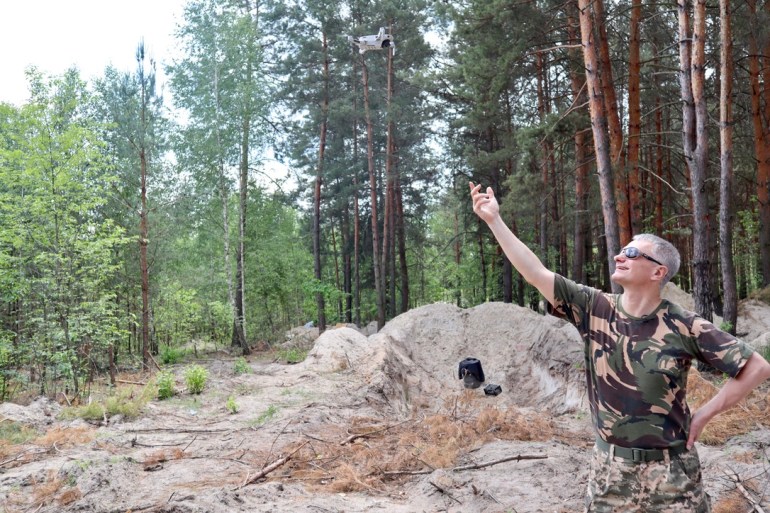In Ukraine, humanitarian drones can save lives
As UAVs continue to change modern warfare, humanitarian drones are carrying out vital missions in Ukraine to save lives.
![Demetriy, a drone pilot with Ukraine’s Armed Forces, demonstrates UAV capabilities in Kyiv Oblast [Shelby Wilder]](/wp-content/uploads/2022/09/3.jpeg?resize=770%2C513&quality=80)
Since Russia’s invasion began, Ukraine’s allies have been sending UAV (unmanned aerial vehicle) assistance.
A crucial component of the war, the usage of drones is complex in legal and technical terms.
Keep reading
list of 4 itemsUkraine claims counteroffensive success to ‘starve the Russians’
Ukraine’s latest weapon in the war: Jokes
Ukraine’s partisans won’t win war but can ‘wreak havoc’: Analysts
But as UAVs have continued to change modern warfare, humanitarian drones carry out vital missions in Ukraine to save lives.
When the war started on February 24, the non-profit Revived Soldiers Ukraine (RSU) contacted DraganFly, a North American-based drone company, to supply its cutting-edge technology.
The base rate for a Draganfly drone is $35,000, but add-ons such as thermal cameras can push costs upward of $80,000.
RSU raised funds to buy multiple units at a discounted rate and intends to use the drones for search and rescue operations, such as scouring destroyed civilian infrastructure for survivors after Russian bombardment.
“The AI camera systems on our drones can read people’s vital signs on the ground,” said DraganFly CEO Cameron Chell.
Delivery missions allow for drones to carry everything from medicine to medical equipment and Draganfly’s UAVs use drone-mounted cold chain systems to transport perishable products requiring refrigeration, such as insulin.
Draganfly recently partnered with the Ukrainian company Def-C to implement de-mining operations.
Landmines litter swaths of Ukrainian land, even after fighting pauses.
Mine-detecting drones are deployed with sensors that can detect ceramics, plastics, and metals – effectively charting these anomalies before experts step into the field.
“This detailed map provides an extra level of protection. De-mining crews can then assess the threat type, such as tank or anti-personnel mines,” Chell said.

The dangerous, intricate task of removing mines and explosive remnants from Ukraine will take decades but UAVs can help minimise time and risk.
Ukraine’s military has also increasingly incorporated drone responses within the country.
Kyiv’s forces aimed to work with international partners to build smaller, more affordable drones within Ukraine to bolster its humanitarian capabilities.
In the forest of the Kyiv region, north of the nation’s capital, Valeriy Borovyk admired a drone mid-flight.
Borovykhas remained head of Alliance New Energy, despite being part of the National Guard of Ukraine.
Before the war, his organisation worked in space and IT sectors, specialising in energy and defence.
When the Ukraine-Russia conflict started in 2014, Alliance New Energy manufactured drones for combat and intelligence purposes.
Now, when not on special forces missions, Borovyk has been strategising the next steps for investment and drone production within Ukraine.
When Russia’s latest war in Ukraine began, Borovyk’s hometown of Chernihiv was encircled. His family was trapped in the city and faced intense Russian bombardment.
Food and medicine shortages soon followed, and then a bomb exploded near his home. Shrapnel injured his mother’s eye during the blast, requiring immediate surgery.
Yet the hospital could not access the necessary medical equipment due to the blockade by Russian troops.
Borovyk suddenly understood the importance of drones for civilian use, and how UAVs could deliver the medical supplies his mother needed.
However, Ukraine’s stretched military resources meant no drones could carry out this civilian operation at the time.
Borovyk’s mother eventually recovered after Russian forces retreated. Still, the experience inevitably shifted his focus from combat drones that could drop grenades to humanitarian drones that could deliver essential goods to Ukrainians in need.
Still, Borovyk’s company has sought financial backing to expand operations.
“With funding, we could make 30 drones per month and collaborate with Lithuanian partners to create even more.”
At approximately 8,000 euros ($8,028) per unit, these UAVs cost significantly less than other manufacturers.
“Hence, if one of our drones is shot down it is not a massive loss,” Borovyk claimed.
An incentive for international investment is that drones are being tested daily in Ukraine.
Borovyk added, “We are constantly learning and adapting in this technological war, experimenting with equipment in actual situations.”
Prioritised modifications aimed to address the increased sabotage threat by Russian forces.
Demetriy, a drone pilot with Ukraine’s armed forces, emphasised the need for an accountable security chain with enhanced encryption, “Signal jamming disrupts the controller-drone communication, while compromised software can reveal drone and pilot locations to enemy forces.”
Demetriy has been training pilots in Ukraine’s National Guard with situational awareness drones to provide surveillance in areas where aid workers are engaged, or civilians are being evacuated.
“Russia’s military has not respected agreed-upon humanitarian corridors, which is a huge problem,” Demetriy said.
UAVs help assess route viability and garner real-time information to protect civilians: “If Ukraine’s military had more drones available for humanitarian use, we could identify Russian military positions, warning civilians and NGOs operating on the ground.”
Borovyk shows a phone application that displays real-time military advances and documents Russian movements.
As territories are absorbed or cut off by Russian forces, leaving residents without aid and unable to flee, Borovyk stressed the need for humanitarian drones, “These scenarios are unfolding across the country and it only underscores the importance of UAVs in Ukraine.”